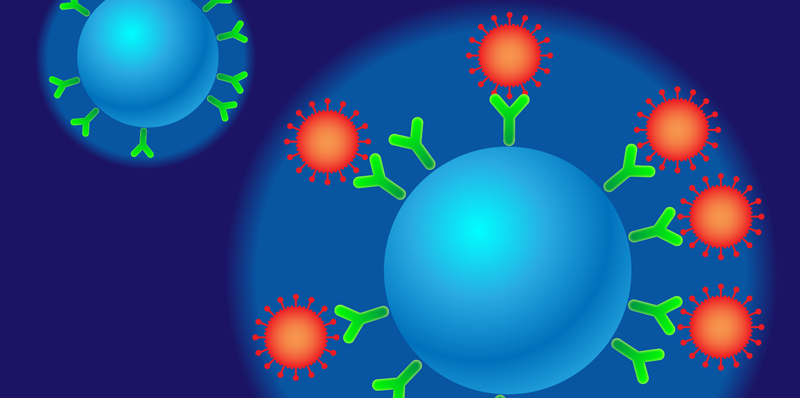A Bead-Based Test for COVID-19
Speaking at a media briefing in mid-March, Tedros Adhanom Ghebreyesus, the Director General of the World Health Organization (WHO), urged all countries to “test, test, test” for COVID-19. Researchers around the globe heeded his call, with many already exploring avenues for scalable testing methods for the virus. Now, a team of New York University researchers led by David Grier, Andrew Hollingsworth, and Kent Kirshenbaum reports promising results with a detection technique based on holography. The researchers say that their technique could be developed into a cheap, fast, and fully automated test for SARS-CoV-2, the virus that causes COVID-19. What’s more, the test could detect both active infection and acquired immunity.
Experts agree that testing for COVID-19 is key to halting the pandemic and returning life to normal. If tests were widely available, those infected with the disease—and their contacts—could be easily identified and then isolated, curbing transmission. According to WHO recommendations released in late March, testing needs to be increased 80-fold from current levels. Right now, in many countries there are barely enough kits for testing the severely ill and medical personnel.
Grier, Hollingsworth, and Kirshenbaum are among those looking to change the situation. Like many scientists, they rapidly shifted their research priorities when the pandemic hit. And they realized that a technique that they had recently developed to tackle a fundamental problem in soft matter physics (measuring the free energy of a collection of particles) could be used for viral detection. Their idea harnesses the technique’s ability to measure the size and refractive index of a microscopic particle with “phenomenal precision,” Grier says.
In the setup, laser light illuminates particles suspended in a fluid as they flow through a microfluidic channel, and suitable optics project holograms of the particles onto a camera. A fast image-processing algorithm then analyses the holograms to extract each particle's diameter. Within half an hour, the setup can measure the diameters of tens of thousands of micrometer-size particles with a precision of a couple of nanometers. “Such precise measurements [could] reveal if there is a virus attached to the particle,” Grier says.
The team’s idea is to detect the virus using tiny plastic beads coated with antibody proteins that bind only to characteristic proteins of SARS-CoV-2. These “functionalized” beads would be mixed into a fluid sample taken from a patient and would bind to the virus particles in the fluid. This binding would cause the diameters of the beads to increase a few nanometers, a change that the researchers’ setup can detect.
To test the idea, the researchers performed two experiments using two different pairs of biological molecules that selectively bind to each other, like locks and keys. In each experiment, lock molecules were attached to the beads, and key molecules were dissolved in the fluid. In the first experiment, the team used vitamin-B-coated beads, which bind to avidin proteins, and in the second, they used protein-A-coated beads, which bind to immunoglobulin G antibodies. The technique successfully revealed the nanometer changes in bead diameters that resulted from the binding.
Conventional methods for testing for COVID-19 are expensive and time consuming, partly because they involve a lengthy series of chemical reactions that attach detectable fluorescent molecules to DNA derived from the virus. If successful for COVID-19 testing, the new holography method would significantly cut down on complexity and cost and could be carried out by modestly trained operators, Grier says.
A promising feature of this method is that it could allow simultaneous measurements of several types of particles that could signal both active and past infections from multiple types of viruses. This so-called multiplexing could be done by having sets of beads with different diameters in the same test. Each set would be coated with a unique lock molecule that would bind to a specific key particle in the sample. “In a single assay, we could test for virus and antibodies for COVID-19, [for] SARS, and [for] regular flu” Grier says.
The team is moving on to the next step—engineering beads that will bind to either to SARS-CoV-2, or to its antibodies. “The preparation of precisely defined beads requires custom synthesis in a specialized chemistry lab, but this [requirement] is not an obstacle to scaling up the technique,” Hollingsworth says. In a few weeks, his bench-scale operation could produce enough beads to screen liters of fluid samples. “That’s enough to perform millions of tests,” Hollingsworth says.
Jef Boeke, director of the Institute for Systems Genetics at NYU Langone Medical Center, who wasn’t involved in the work, says that the technique holds “tremendous potential” for antibody testing, which could uncover a past COVID-19 infection. And he envisions the method could spot antibodies signaling other diseases, such as some cancers. However, he says that using the technique to detect an active infection could be trickier, since the concentration of SARS-CoV-2 particles in a test swab sample is very small.
The researchers are eager to forge ahead to test the technique’s sensitivity to COVID-19 but doing so comes with challenges. “Just getting into the lab is a difficult thing,” Grier says. And the supply chains for the needed materials are disrupted. But he adds, “everyone is pulling out all the stops.” The researchers have established a connection with biomedical researchers at NYU Langone hospital who could provide patient samples and another connection with engineers who could make robots for automated sample handling in high-throughput tests. Grier says that he is hopeful that they will get a prototype running within “weeks to months.”
–Matteo Rini
Matteo Rini is the Deputy Editor of Physics.
Correction (16 April 2020): The story has been updated to correct the first name of Kirshenbaum, which is Kent, not Ken as previously stated.





